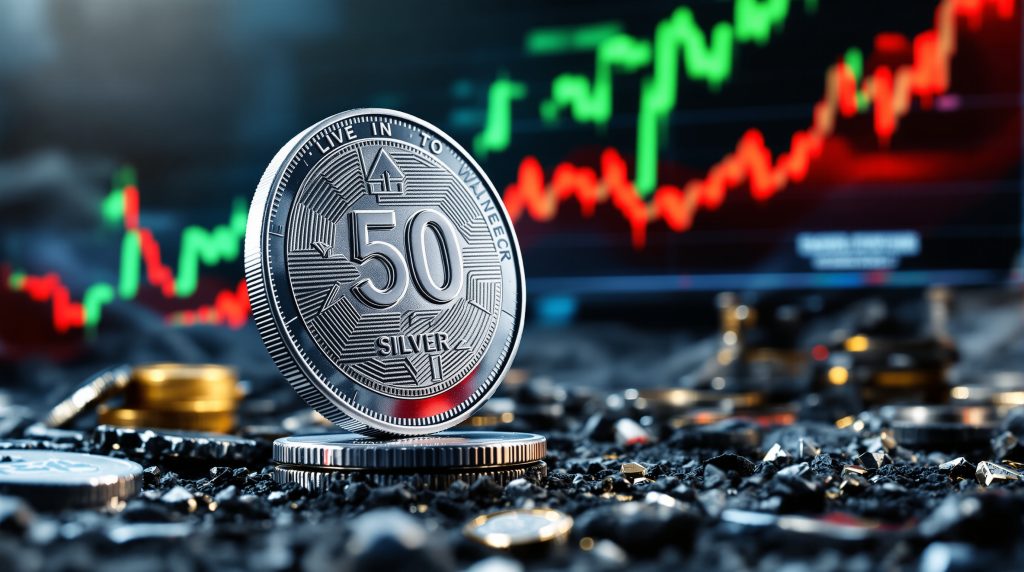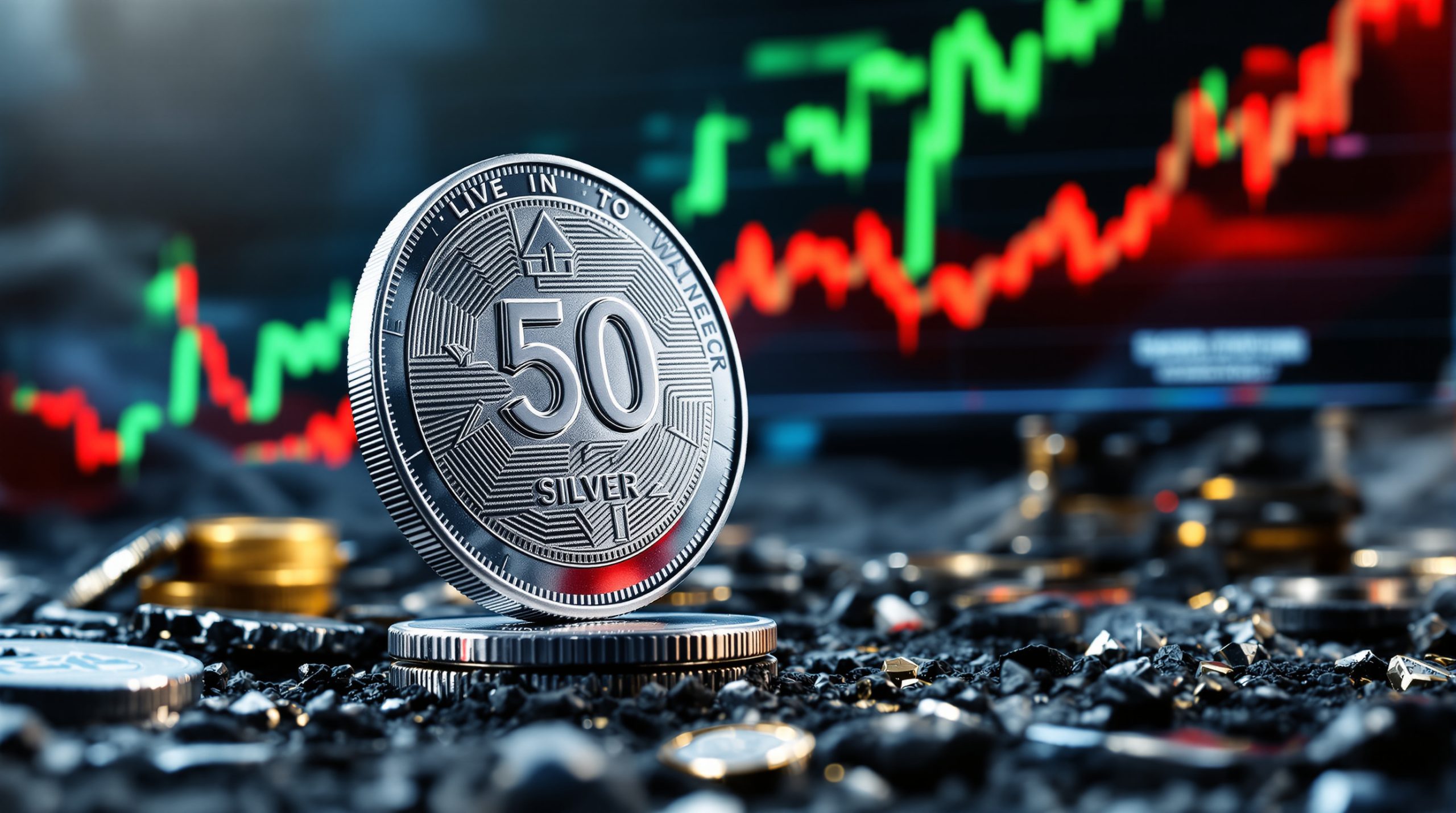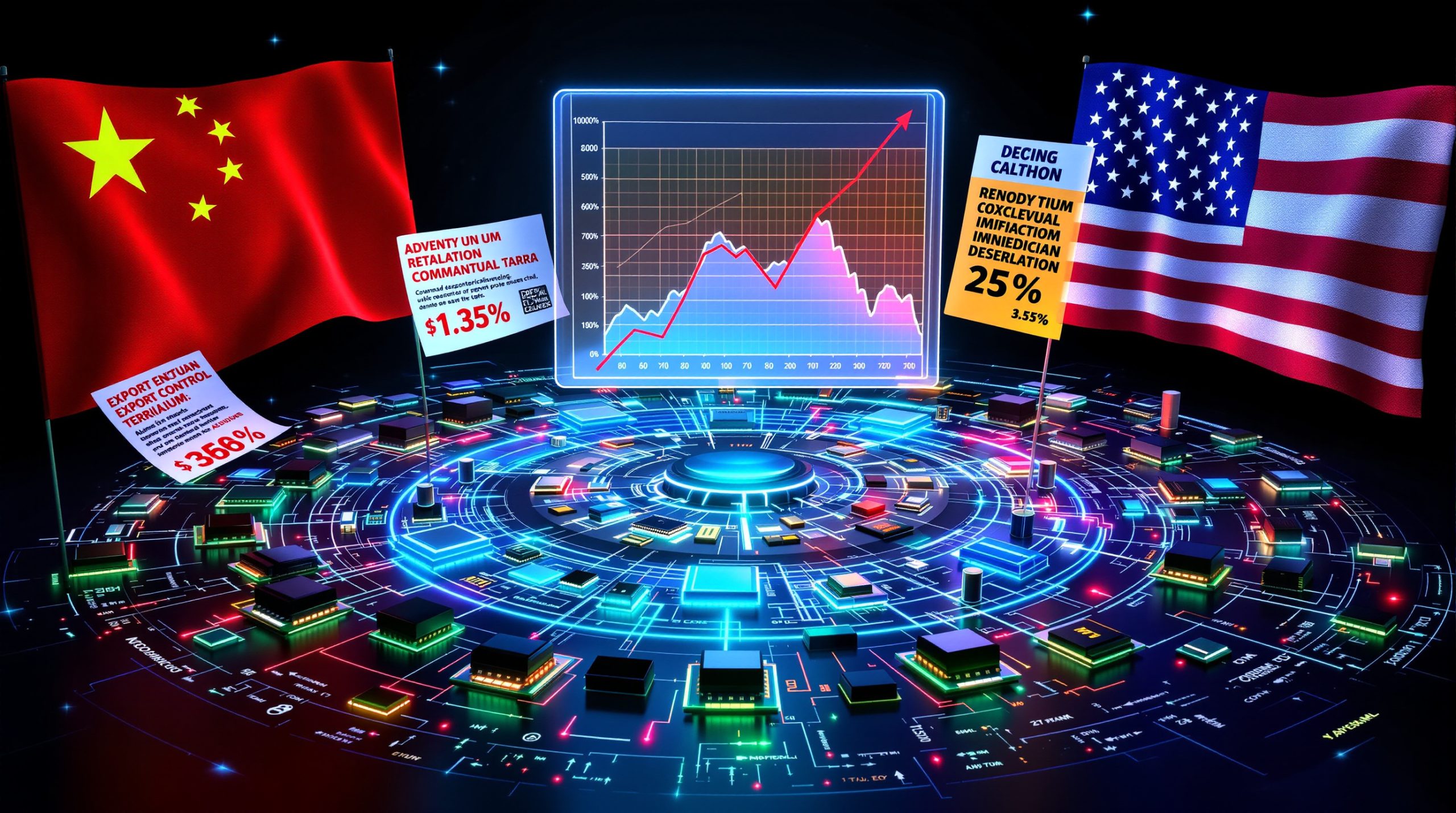Silver Price Correction: What's Next for the Precious Metal?
Silver has experienced a remarkable rally recently, touching the psychologically significant $50 per ounce level—a price not seen in over four decades. This milestone represents a critical juncture for the precious metal as it confronts long-term resistance levels dating back 45 years. The metal's performance has outpaced gold in percentage terms, reflecting increased investor interest and strong fundamental drivers.
Key Performance Metrics
Silver recently closed above $50 per ounce in spot markets, marking a significant achievement for the precious metal. According to World Bank Commodity Price Data, silver previously peaked at approximately $48.70 per ounce in April 2011, making the current rally even more significant as it breaks through long-established resistance levels.
Gold has maintained strength above the $4,000 level, providing support for the entire precious metals complex. This synchronous strength in both metals suggests broad-based interest in the sector.
The gold-silver ratio analysis has compressed significantly from pandemic-era extremes. Kitco historical data shows the ratio has moved from above 90:1 in 2020 to current levels around 80:1 (calculated as $4,000 gold ÷ $50 silver), indicating silver's stronger relative performance.
Silver has outperformed major stock indices on a relative basis, breaking out from a four-year bottoming pattern against the S&P 500. This suggests increasing capital rotation from traditional investments into precious metals.
Technical Indicators Flashing Warning Signs
Despite the impressive price action in the metals themselves, mining equities have begun to diverge from the underlying commodities—a classic warning sign that the rally may be losing momentum. While silver and gold posted strong weekly gains, mining stocks showed weakness, with GDX (VanEck Gold Miners ETF) closing down for the week and GDXJ (VanEck Junior Gold Miners ETF) barely managing to stay above flat.
This negative divergence between metals and miners often precedes corrections in the broader precious metals complex. Technical analysts consider such divergence particularly meaningful as mining stocks typically lead the metals due to their operational leverage.
The Silver Institute's World Silver Survey 2024 projects continued supply deficits, with the silver market experiencing a deficit of 184.3 million ounces (Moz) in 2023, marking the third consecutive year of deficit. Despite these strong fundamentals, the warning signs in mining equities suggest caution is warranted in the near term.
Why Are Mining Stocks Signaling Caution?
The disconnect between physical metals and mining stocks has become increasingly evident in recent trading sessions, raising red flags for experienced precious metals investors.
Bearish Divergence Between Metals and Miners
The recent trading patterns show a concerning disconnect:
- Gold and silver posted strong weekly gains while GDX closed down for the week
- GDXJ barely managed to stay above flat despite record metal prices
- Silver mining stocks showed mixed performance despite silver's strength
- SIL (Global X Silver Miners ETF) formed bearish weekly candle patterns
This divergence is particularly notable given that mining stocks typically amplify the moves in the underlying metals due to operational leverage. When miners underperform during a metals rally, it often signals smart money rotating out of the sector ahead of an anticipated silver market squeeze impact.
Technical Analysis Warning Signs
The weekly charts for mining stocks reveal several bearish formations:
- Hanging man candlestick patterns appearing in multiple mining ETFs
- Exhaustion at measured upside targets
- Volume declining on rallies
- Failure to make new highs alongside the metals
According to technical analysis literature, hanging man patterns are characterized by small real bodies at the upper end of the trading range with long lower shadows and minimal upper shadows. Steve Nison, in "Japanese Candlestick Charting Techniques," identifies these patterns as signaling potential exhaustion of buying pressure—precisely what appears to be happening in mining stocks currently.
SIL, the large silver miners ETF, reached its measured upside target of approximately $74 before peaking around $75. Similarly, SILJ (ETFMG Prime Junior Silver Miners ETF) approached its target of $26-27 before showing signs of reversal. These technical targets being reached coincides with the bearish reversal patterns, reinforcing the correction thesis.
What Support Levels Should Investors Watch?
As the precious metals sector approaches what appears to be a near-term top, identifying key support levels becomes crucial for investors looking to add positions during the expected consolidation phase.
Gold Support Zones
If gold has indeed peaked near current levels, several key support areas emerge:
- Initial support around $3,750 (recent breakout level)
- Secondary support at $3,600 (psychological level)
- Strong technical support near $3,500 (potential convergence with rising 200-day moving average by late November/early December)
The 200-day simple moving average (SMA) is particularly significant as it has historically provided reliable support during bull market corrections. According to John J. Murphy's "Technical Analysis of the Financial Markets," the 200-day SMA is widely followed as a long-term trend indicator, with prices above this moving average generally considered bullish.
Silver Support Levels
For silver, the potential correction targets include:
- Gap fill area around $42-43
- Acceleration point at $41 (where the recent rally gained significant momentum)
- Rising 200-day moving average approaching $40-41 by year-end
These levels represent potential buying opportunities for investors looking to establish or add to positions during the expected consolidation phase. According to CPM Group's Silver Yearbook, historical support levels in silver markets tend to cluster around psychologically significant round numbers and previous breakout/breakdown levels.
The convergence of multiple support factors around the $40-41 level makes this zone particularly significant for silver, potentially offering strong buying opportunities if reached during the silver price correction.
How Long Might a Silver Correction Last?
Understanding the potential duration and depth of a silver correction can help investors develop appropriate strategies and maintain perspective during periods of price weakness.
Historical Correction Patterns
Based on previous silver bull markets, corrections following major advances typically:
- Last between 2-5 months
- Retrace 30-50% of the preceding rally
- Create a base for the next major advance
- Shake out speculative excess before resuming the uptrend
Federal Reserve Economic Data (FRED) shows that during the 2010-2011 silver bull market, multiple corrections occurred:
- August 2010: Silver declined approximately 15% over 6 weeks (from ~$19 to ~$16)
- January 2011: Approximately 20% decline over 3 weeks (from ~$31 to ~$25)
- May 2011: Following the April 2011 peak near $48, silver corrected approximately 35% by late June 2011
Research published in the Journal of Futures Markets indicates that precious metals corrections following significant rallies typically exhibit higher volatility than the preceding advance, with the speed of decline often faster than the speed of the preceding rally.
Current Cycle Projections
The current technical setup suggests:
- A correction and consolidation period likely lasting into early 2026
- Potential for a multi-month basing pattern
- Opportunity for accumulation before the next major advance
- Building technical strength for an eventual breakout above $50
This consolidation period would be constructive rather than destructive—essentially building fuel for silver's next major advance. The formation of a proper base following the recent strong advance would allow for healthier, more sustainable price appreciation when the uptrend resumes.
Is Silver's Long-Term Bull Case Still Intact?
Despite the likelihood of a near-term correction, multiple fundamental factors continue to support a strong long-term outlook for silver prices.
Fundamental Drivers Remain Strong
The structural case for higher silver prices remains compelling:
- Persistent supply deficits projected through 2025 and beyond
- Industrial demand growth from green energy transition
- Investment demand increasing as inflation protection
- Limited new mine supply coming online
- Declining above-ground inventories
The Silver Institute's World Silver Survey 2024 documents ongoing supply deficits, with 2023 showing a 184.3 Moz deficit and projections for 2024 indicating an approximately 215.3 Moz deficit. Cumulative deficits since 2021 exceed 500 Moz, representing a substantial drain on available silver supplies.
Industrial demand continues to grow, particularly from the renewable energy sector. The International Energy Agency reports that solar photovoltaic (PV) installations are projected to continue growing significantly, with approximately 440 GW added globally in 2023 and potentially exceeding 500 GW in 2024. With silver consumption per GW of solar capacity at approximately 0.8-1.0 million ounces, this represents substantial ongoing demand.
According to the Silver Institute, identifiable above-ground silver stocks (excluding coins and jewelry) were estimated at approximately 1.74 billion ounces in 2022. Monitored exchange inventories on COMEX and LBMA have shown declining trends, with COMEX silver inventories falling from a peak of approximately 400 million ounces in 2021 to approximately 280 million ounces by late 2024.
Rate-of-Change Analysis Suggests Room to Run
When examining silver's current rally compared to previous bull market peaks:
- The 50-day rate of change is below levels seen at major tops in 2004, 2006, and 2011
- The 100-day rate of change remains well below previous bull market extremes
- Current momentum indicators suggest the rally is not yet overextended compared to historical precedents
The Rate of Change (ROC) indicator measures the percentage change in price between the current price and the price n periods ago. According to Steven B. Achelis' "Technical Analysis from A to Z," this momentum oscillator helps identify potential extremes in market sentiment.
The fact that silver's current momentum readings remain below previous bull market peaks suggests the overall advance has room to continue after the expected consolidation phase. This analysis indicates that while a silver price correction is likely imminent, the overall bull market remains in its middle stages rather than at a terminal point.
What Could Happen After Silver Breaks $50?
Looking beyond the anticipated correction, silver's potential trajectory after conclusively breaking through the $50 resistance level deserves consideration.
Potential Price Targets
Once silver conclusively breaks through the $50 resistance level after the coming correction:
- Technical analysis suggests a potential move to $95 within 12-18 months
- The cup formation on long-term charts points to significant upside
- Historical precedent indicates accelerated price movement once multi-decade resistance is overcome
- The $100 level becomes a realistic longer-term target
The cup and handle pattern identified on silver's long-term chart is particularly significant. According to William J. O'Neil's "How to Make Money in Stocks," this bullish continuation pattern consists of a U-shaped price consolidation (the cup) followed by a short-term pullback near the prior high (the handle). When price breaks above the handle resistance, the measured move target is typically equal to the depth of the cup added to the breakout point.
While specific price velocity statistics for silver following major breakouts are limited, historical price data shows the 2010-2011 rally saw silver increase approximately 167% in just 8 months. The potential for similar or greater price appreciation exists once silver decisively breaks above long-term resistance.
Fundamental Catalysts for the Next Leg Higher
Several factors could drive the next major advance in silver prices:
- Further monetary policy easing by central banks
- Continued institutional adoption of precious metals
- Supply constraints becoming more acute
- Industrial demand accelerating from green energy transition
- Geopolitical tensions driving safe-haven demand
Bank for International Settlements data shows global central bank balance sheets have expanded dramatically since 2008, with the Federal Reserve's balance sheet growing from approximately $900 billion in 2008 to a peak of approximately $9 trillion in 2022. Similar expansion patterns are evident with the European Central Bank and Bank of Japan. This unprecedented monetary expansion creates an environment where hard assets like precious metals may see increased investment demand.
The World Bank's "Minerals for Climate Action" report identifies silver as one of the critical minerals for clean energy technologies, with demand expected to increase significantly from electric vehicles, solar panels, and wind turbines. This growing industrial application base provides underlying support for silver prices independent of investment demand.
How Are Capital Flows Changing in the Precious Metals Sector?
Understanding how investment capital is moving within and toward the precious metals sector provides important context for the current market environment.
Rotation from Traditional Assets to Precious Metals
Recent market action reveals important capital flow trends:
- Gold and silver mining stocks have broken out against the 60/40 portfolio benchmark
- This indicates increasing capital rotation from traditional assets into the precious metals sector
- The breakouts occurred from 12-year bases, suggesting a major trend change
- Both large miners and juniors are participating in this rotation
The 60/40 portfolio refers to a traditional balanced portfolio allocation of 60% equities (typically S&P 500) and 40% fixed income (typically intermediate Treasury bonds). The fact that precious metals stocks are outperforming this benchmark indicates a significant shift in institutional allocation preferences.
According to the World Gold Council, gold ETF holdings have shown significant growth, with global gold ETF holdings in 2024 reaching approximately 3,200 tonnes. North American gold ETF holdings represent the largest regional concentration at approximately 1,400 tonnes. These holdings reflect substantial institutional participation in the precious metals markets.
Changing Investment Patterns
The capital flow analysis shows:
- Initial flows concentrated in major producers
- Gradual expansion into mid-tier producers
- Beginning of interest in junior developers and explorers
- Pattern typical of early-to-middle stages of precious metals bull markets
Morningstar Direct data on fund flows shows precious metals equity funds experienced cyclical patterns, with outflows during the 2013-2019 bear market in gold, returning to net inflows starting in 2020, and renewed interest in 2024 coinciding with gold price strength.
This progression from large producers to juniors typically occurs as bull markets mature, with capital gradually moving down the risk spectrum in search of greater leverage to rising metal prices. The current pattern suggests the bull market has room to run, with junior companies likely to see increasing investor interest as the cycle progresses.
How Should Investors Approach the Coming Correction?
Navigating a correction in a bull market requires different strategies than surviving a bear market. The expected silver correction presents both challenges and opportunities for investors.
Strategic Considerations
For investors looking to navigate the expected consolidation phase:
- Hold existing core positions in physical metals
- Consider trimming overextended mining positions
- Prepare watchlists of quality companies for accumulation during weakness
- Focus research efforts on identifying the highest-quality silver producers and developers
- Look for companies with the strongest assets and greatest leverage to rising silver prices
According to portfolio management literature, position sizing and risk management during volatile commodity cycles should consider volatility adjustment, as precious metals mining stocks historically exhibit 2-3 times higher standard deviation than the underlying metals. Correlation analysis is also important, as mining stocks show higher correlation to equity markets during market stress periods.
Systematic rebalancing helps manage position concentration risk. Maintaining discipline during corrections is essential for long-term success in cyclical sectors like precious metals.
Research Focus During Consolidation
The correction period provides an excellent opportunity to:
- Evaluate company fundamentals thoroughly
- Compare production costs across producers
- Assess exploration upside potential
- Analyze management track records
- Identify companies with 5-10x potential in the next major advance
Key evaluation metrics for mining companies include all-in sustaining costs (AISC) per ounce, reserve life and resource grades, jurisdictional risk assessment, management track record, and balance sheet strength. These criteria help identify companies best positioned to outperform during the next leg of the bull market.
The consolidation period allows investors time to conduct thorough due diligence without the pressure of rapidly rising prices. This methodical approach to research can lead to better investment decisions and superior long-term results.
What Technical Indicators Confirm the Correction Thesis?
Multiple technical indicators currently suggest the precious metals sector is due for a correction, providing confirmation of the overall thesis.
Bearish Reversal Patterns
Several technical formations support the correction thesis:
- Bearish hanging man candlestick patterns in multiple mining ETFs
- Divergence between price and momentum indicators
- Volume declining on recent advances
- Measured move targets being reached
- Negative divergence between metals and miners
Thomas N. Bulkowski's "Encyclopedia of Chart Patterns" describes the measured move as a technical analysis method that projects price targets based on previous price patterns. This involves identifying the height of a consolidation pattern (base), adding this distance to the breakout point, and using the result as an upside price target.
SIL (large silver miners ETF) reached its measured target of approximately $74 before peaking around $75, while SILJ approached its target of $26-27 before showing signs of reversal. These technical targets being reached coincides with the bearish reversal patterns, reinforcing the correction thesis.
Silver Stocks' Warning Signs
The silver mining sector shows particular weakness:
- SILJ formed a bearish inverted hammer pattern
- SIL showed exhaustion at measured upside targets
- Two consecutive weeks of bearish candle formations
- Failure to make new highs alongside silver's advance
The weekly charts for silver mining stocks reveal bearish candle patterns over the past two weeks, with particularly concerning formations in SILJ. These patterns suggest exhaustion of buying pressure and potential for near-term weakness despite continued strength in the underlying metal.
The fact that mining stocks are failing to make new highs alongside the metals indicates diminishing buying interest from institutional investors, who typically focus more on mining equities than physical metals due to their operational leverage and greater total return potential.
FAQ About the Silver Market
Is silver overvalued at current prices?
While silver has seen a substantial rally, it remains undervalued relative to gold by historical standards. The gold-to-silver ratio, though compressed from recent extremes, still suggests silver has room to appreciate over the longer term. Considering the persistent supply deficits and growing industrial demand, current prices may actually understate silver's fundamental value despite the impressive recent gains.
How does industrial demand affect silver prices?
Industrial demand accounts for approximately 50% of silver consumption, making it a significant price driver. According to the Silver Institute's World Silver Survey 2024, industrial fabrication accounted for approximately 539 million ounces in 2023, representing roughly 50% of total silver demand of 1.079 billion ounces. The green energy transition, including solar panels and electric vehicles, continues to increase industrial silver demand.
The International Energy Agency projects continued strong growth in solar PV installations, which consume approximately 0.8-1.0 million ounces of silver per GW of capacity. With annual installations potentially exceeding 500 GW in 2024, this represents substantial ongoing demand.
What role do mining stocks play as leading indicators?
Mining stocks often act as leading indicators for precious metals prices due to their operational leverage. When miners underperform the metals they produce, it frequently signals an impending correction in the broader sector. This dynamic occurs because institutional investors and industry insiders typically have greater insight into sector fundamentals and position accordingly before retail investors recognize changing trends.
The current negative divergence between silver prices and silver mining stocks represents a classic warning sign that has preceded corrections in previous cycles. While not infallible, this indicator deserves serious consideration in the current context.
How might central bank policies affect silver in 2026?
Expected interest rate adjustments and continued monetary accommodation create a supportive environment for precious metals. Lower real interest rates reduce the opportunity cost of holding non-yielding assets like silver. Bank for International Settlements data shows the unprecedented expansion of central bank balance sheets since 2008, creating an environment where hard assets may see increased investment demand as a hedge against monetary debasement.
The current divergence between physical demand and available supply, combined with accommodative monetary policy, creates a potentially explosive setup for silver prices once the current correction runs its course.
What distinguishes this silver bull market from previous cycles?
The current silver bull market features stronger fundamental supply-demand imbalances, greater industrial applications, and occurs against a backdrop of unprecedented monetary expansion—potentially making it more durable than previous cycles. The Silver Institute documents ongoing supply deficits, with 2023 showing a 184.3 Moz deficit and projections for 2024 indicating an approximately 215.3 Moz deficit.
Additionally, silver's role in green energy technologies provides structural support not present in previous bull markets. The World Bank identifies silver as a critical mineral for clean energy technologies, with demand expected to increase significantly from electric vehicles, solar panels, and wind turbines.
Preparing for Silver's Next Major Move
The technical and fundamental evidence strongly suggests that silver's impressive rally is due for a correction and consolidation phase. Rather than signaling the end of the bull market, this healthy pullback will likely set the stage for silver's eventual decisive break above $50 and potential move toward $100.
Investors should view the coming correction as an opportunity rather than a threat—a chance to position themselves in quality silver companies before the next major advance. By focusing research efforts during the consolidation phase, investors can identify the producers and developers best positioned to deliver substantial returns when silver eventually breaks through long-term resistance.
The fundamental drivers supporting higher silver prices remain intact, with persistent supply deficits, strong industrial demand, and increasing investment interest. According to portfolio management best practices, maintaining discipline during corrections is essential for long-term success in cyclical sectors like precious metals.
The most successful investors will use the consolidation period to evaluate company fundamentals thoroughly, compare production costs across producers, assess exploration upside potential, analyze management track records, and identify companies with multi-bagger potential in the next phase of the bull market.
While near-term weakness appears likely based on technical warning signs in mining equities, the longer-term outlook for silver remains exceptionally bullish, supported by both technical and fundamental factors that point to substantially higher prices in the years ahead. The mining industry evolution and the ongoing silver squeeze movement will continue to drive gold-silver market trends for years to come.
Want to Catch the Next Major Mineral Discovery Before It Explodes?
Discover how savvy investors are positioning themselves ahead of the next ASX resource stock surge with real-time alerts from Discovery Alert's proprietary Discovery IQ model. Visit https://discoveryalert.com.au/discoveries/ to explore historical returns from major mineral discoveries and begin your 30-day free trial to gain that critical market advantage.




